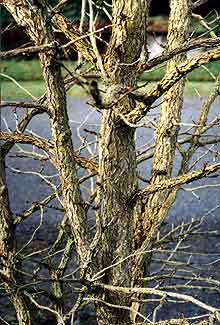 Selecting Trees & Shrubs for Their Winter Bark
Selecting Trees & Shrubs for Their Winter Bark
"Now transmuted, we swiftly escape, as Nature escapes;
We are Nature -- long have we been absent, but now we return;
We become plants, leaves, foliage, roots, bark."
-Walt Whitman
(1819-1892)
(1819-1892)
There are some shrubs that will look homely & cease to bloom if not pruned each year, & it's usually the older "bloomed out" branches that need to be removed. Those sorts of bushes rarely have time to develop bark with lots of character, though young twig-bark does often have vibrant & unusual colors that fades on older limbs.
The beauty of crusty old bark is one reason I so often prefer woody shrubs & trees that don't necessarily require much in the way of pruning. Preserving the older branches & letting them accumulate size lends them increasing character over time.
Come winter, when a lot of deciduous specimens are naked, when most perennials have died to the ground, & annuals have completed their life cycle altogether, the shapes of trunks & limbs, & the varied textures & colorations of barks, become a tremendous feature. If shrubs & trees were selected with their leafless appearance & barks also in mind, this assures a garden's all-seasons delight.
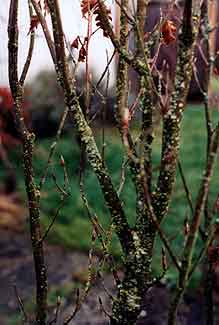 At the top of the page is our lamented Turkish filbert (Corylus colurna) which we had by the road. For me this was the tree I always see in a perfect dream of winter. It's upright form was so beautiful even without leaves, & the deeply cracked & scarred-looking bark, on trunk & young limbs alike, was most striking.
At the top of the page is our lamented Turkish filbert (Corylus colurna) which we had by the road. For me this was the tree I always see in a perfect dream of winter. It's upright form was so beautiful even without leaves, & the deeply cracked & scarred-looking bark, on trunk & young limbs alike, was most striking.The Dawn Viburnum (Viburnum bodnantense) not only has interesting bark, but it even blooms in winter. Next to the winter-blooming viburnum are two Japanese Barberries which lose their leaves by about November but hold onto tiny red berries into winter. Much else by the roadside has been chosen for some aspect that remains pleasing in winter.
The second bark portrait is of the Rohani beech (Fagus sylvatica 'Rohanii') in our woodsy front yard. It's also known as Oakleaf Beech, Rohan European Beech, or Serated-Leaf Rohani. It's mottled bark is particularly striking. The trunk & main branches have all developed a speckled & mossy appearance that is totally captivating in winter.
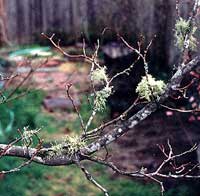 We've planted the Rohani near the side of the main walkway opposite the Paperbark Maple, the page for which has a portrait of the cinnamon-colored peeling bark which is another winner for winter appearance.
We've planted the Rohani near the side of the main walkway opposite the Paperbark Maple, the page for which has a portrait of the cinnamon-colored peeling bark which is another winner for winter appearance.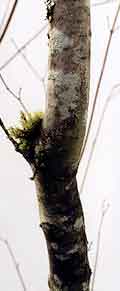 The third & fourth bark portraits are details of a gnarly Vine Maple (Acer circinatum) in our back yard. Its bark is speckly, somewhat like the Rohani's. There is not a limb anywhere on the tree that does not have "balls" of lichen or moss growing on it, as shown in these details.
The third & fourth bark portraits are details of a gnarly Vine Maple (Acer circinatum) in our back yard. Its bark is speckly, somewhat like the Rohani's. There is not a limb anywhere on the tree that does not have "balls" of lichen or moss growing on it, as shown in these details.The moss is well-hidden among leaves most of the year, but in winter these are revealed as virtual leaf-substitutes. Vine maple is one of our finer local native species with varying appearance in each season — spring flower, later spring & summer lushness of leaves, striking autumn colors, then a display of its speckled bark & twisty limbs.
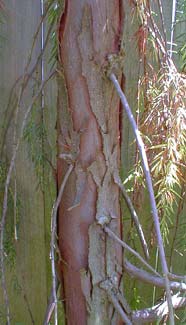 Evergreen conifers generally have very beautiful bark. Shown last on this page (here at the left) is the exfoliating bark of a Formosan Juniper. Cracked & beautifully textured barks are also to be seen on our Alaska Cedar & the Cedar of Lebanon, among others.
Evergreen conifers generally have very beautiful bark. Shown last on this page (here at the left) is the exfoliating bark of a Formosan Juniper. Cracked & beautifully textured barks are also to be seen on our Alaska Cedar & the Cedar of Lebanon, among others.We have many other shrubs & trees with striking winter bark, including the following: Nishiki Willow a shrub whose twigs turn red in winter; the Red-twig Dogwood for its wine-red limbs; the tortured Young's weeping birch for its white cracked bark & winter catkins; the Green Weeping Beech & the Black Swan Beech for their twisty limbs & mottled bark; the Corkscrew Hazel for it's macabre limbs & winter's golden catkins; Witch Hazel for its crusty bark & winter blossoms; Diablo Ninebark & Summersweet both of which have twiggy winter appearances with exfoliating older branches; Pacific Red Elderberry with warty speckled bark; Climbing Hydrangea for its bright orange exfoliating winter bark; Chinese Mountain Ash with pink bark when young; Lion's Head Maple with its bark yellowest in winter.
There's much more from our gardens that could be cited for bark features. If one includes enough of this kind of variety, a beautiful garden is insured even at the starkest time of the year.
The character of bark is just one thing to consider for a winter appearance. Evergreens are obvious choices to keep greenness in the yard year-round, whether needled trees, or broadleaf evergreen varieties of azaleas & rhododendrons, not to mention the winter-blooming evergreen Camellia sasanqua. There are more winter-blooming flowers than you might think, & worth striving to mix into one's garden as many examples as possible.
Or consider the lingering berries that last the winter through on many evergreen & deciduous shrubs & trees. Our gardens include winter-berried specimens that are red, orange, white, pink, black, & violet. A sampling can be viewed in the Winter Berries Gallery. So when planning out your garden, don't think of nurseries as places to visit only in spring to ponder what next you may wish to add. Visit them in autumn to judge fall colors of plants you may wish to consider, & in winter to judge trunk & branch forms of deciduous woody plants. If you select things only in spring in full leaf or full flower, without knowing what their appearance will be in other seasons, you may be cheating yourself.
Now Begin with Page One of the
Winter Bark Garden Walk Gallery